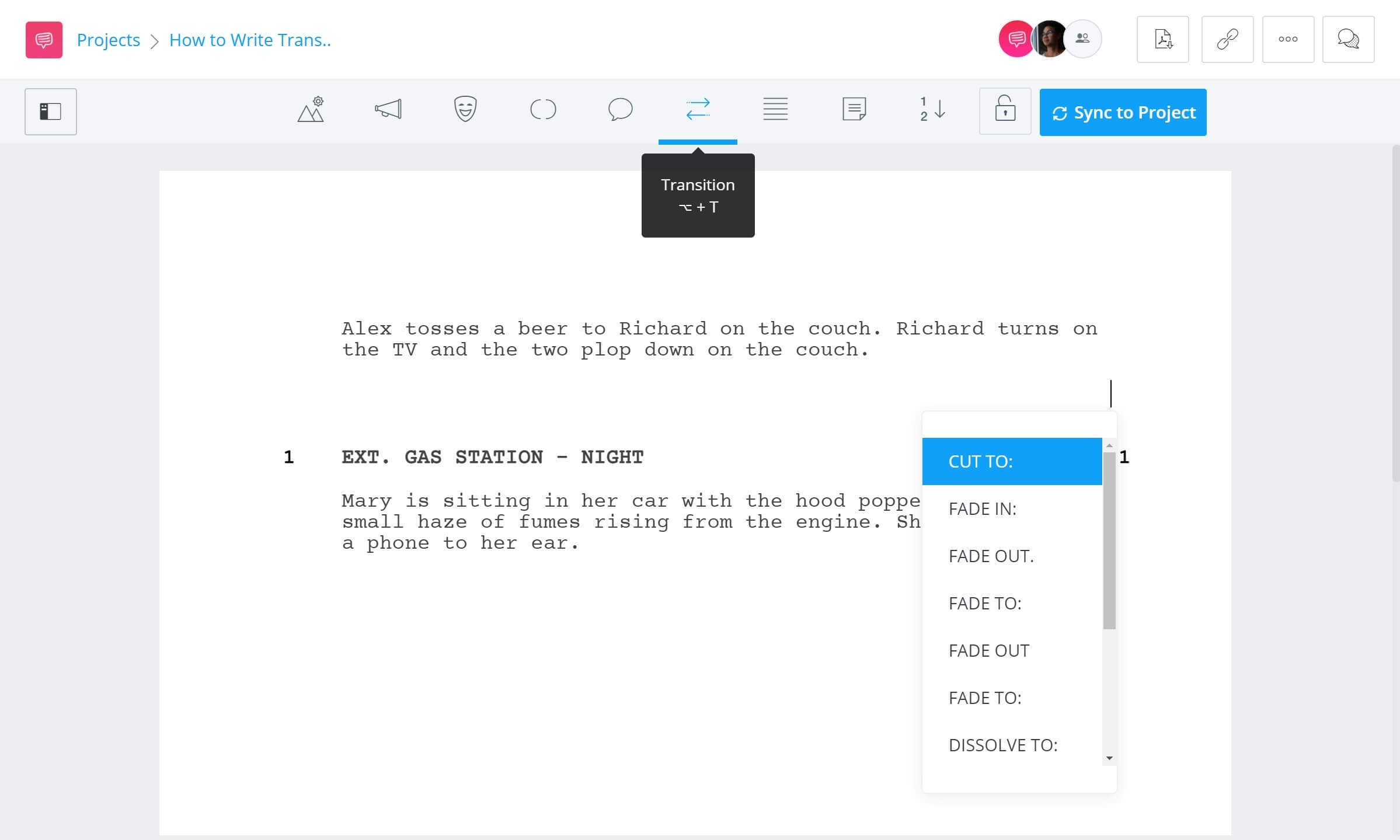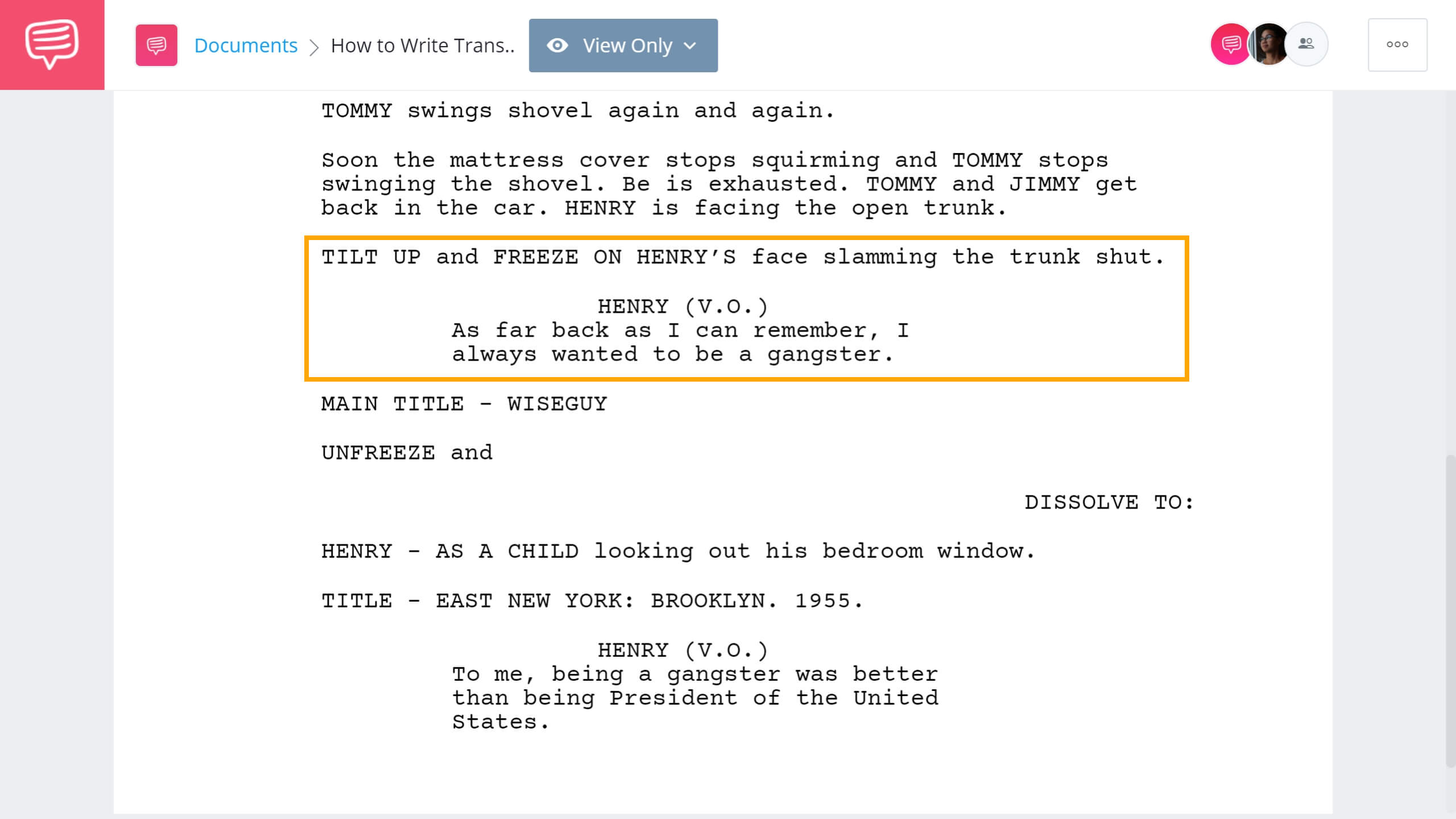S
creenplay transitions in cinema have been used ever since filmmakers had the ability to edit. At first, what was a simple cue to an editor of when to cut to another shot or scene has become another tool for a filmmaker to creatively tell a story. Fades, wipes, and match cuts are a few examples of how the transition has evolved to more creative uses. It is important for any screenwriter to understand the format and use of transitions in a screenplay to make them a more well-rounded writer. Let’s dive into how to write transitions in a script and when to use them.
How to write transitions in a script
Formatting screenplay transitions
Before we dive into the types and uses of screenplay transitions, let’s first clarify how screenplay transitions are formatted. Each transitional instruction, such as “DISSOLVE TO:”, should appear at its own margin. The standard indentation is 6.0 inches from the left edge of the page. In other words, the transition would begin 2.5 inches from the right edge.
However, utilizing screenwriting software can be much easier and more efficient. When using the StudioBinder screenwriting software, simply select the “Transitions” icon at the top toolbar and a drop down menu will appear with different options. Select the transition you wish to use. It’s as easy as that.

How to write transitions in a script
Transitions can serve as unique ways for a film to visually flow. Let’s explore a list of transitions that filmmakers and screenwriters have used to tell their stories.
How to write transitions in a script
DISSOLVE TO:
The dissolve is a gradual transition of one image to another. Dissolves often utilize the overlap of two shots together to suggest a link between the two or to suggest a passage of time between two scenes.
The Film Dissolve: The Hardest Cut
How to write transitions in a script
FADE IN/FADE OUT:
What does fade in mean in a script? The contemporary use of the dissolve transition has made the FADE IN/FADE OUT a rarity within a screenplay. It is most often only used in the beginning of a screenplay with FADE IN: and at the end of a screenplay with FADE OUT:
How to write transitions in a script
FREEZE FRAME:
A freeze frame is utilized to communicate that whatever is on frame freezes as a still frame and holds for a brief moment. This technique is one of the many in Martin Scorsese's directing style. For example, this moment in Goodfellas.
Freeze frame • Goodfellas
We brought the Goodfellas script into the StudioBinder screenwriting app to analyze how the freeze frame was written into the script. Notice how this script utilizes the transition within the action description rather than as a slugline.
How to write transitions in a script • Goodfellas
The use of the freeze frame works especially well within the action description of this scene since it more accurately communicates how abrupt the freeze frame will occur visually.
How to write transitions in a script
JUMP CUT TO:
Jump cuts in film occur when two sequential shots of the same subject are taken from camera positions that only vary in the slightest manner possible. In some cases, the camera position may not move at all. The edit gives the impression the subject has moved forward in time.
A great example of this can be found in The Royal Tenenbaums, one of Wes Anderson’s best films. Be aware this scene does contain graphic spoilers.
Script transitions examples • The Royal Tenenbaums Shaving Scene
While the transition wasn’t written into the screenplay itself, you may want to incorporate a jump cut into your screenplay as you write in the format we mentioned above. Wes Anderson uses the jump cut in this scene logistically to speed up the time and jump through the actions of shaving which would otherwise be a long shot and scene.
It can also be argued that the jump cut is rather abrupt and unsettling leaning into the subject matter of the scene.
Script transitions
IRIS IN/IRIS OUT:
This transition mirrors the visual effect of the iris of a human eye closing in on or opening up around a subject of a frame. It was more widely used in early cinema as a way to end a film and was in fact done in camera.
Recently, filmmakers have utilized it as a stylistic choice often mid scene. Paul Thomas Anderson uses the iris transition to communicate the sexual attraction of one character to another in his 1997 film Boogie Nights.
Script transitions examples • Boogie Nights Pool Scene
Script transitions
MATCH CUT TO:
A match cut is any transition, audio or video, that uses the elements from the previous scene to fluidly bring the viewer through to the next scene, and they have the ability to do so with both impact, and subtext.
Match cuts can match various shot elements such as shapes, movement, or sound. One of the most brilliant match cuts in cinema history can be found in the Kubrickian style of 2001: A Space Odyssey. Stanley Kubrick brilliantly uses a match cut of a bone to a satellite to jump millions of years in time.
Scene transitions • Cinefix Best Moments of Editing
Script transitions
WIPE TO:
The wipe transition literally wipes one shot in any direction to transition to the next shot. The most well-known examples of this can be found in any Star Wars movie. This transition is a throwback to films from the '30s and '40s and we don't see them much these days.
How to write transitions in a script • Star Wars
Wipes are great to signal to an audience that we are jumping to a different location or time. Remember, however, to use wipes to add to a story and not in place of a simple CUT TO: transition.
Scene transitions
SMASH CUT TO:
The smash cut utilizes the contrast between two shots to make a cut more abrupt. This can be a cut between a chaotic moment to a calm moment, a loud shot to a quiet shot, or a crowded shot to an isolating shot. Quentin Tarantino uses the smash cut in Pulp Fiction between a dream sequence that connects a past memory to the present.
Scene transitions in Pulp Fiction • Butch’s Dream
Next time you watch a film, be sure to notice the screenplay transitions and how they affect your experience so that you can gain inspiration for how to use them in your next project.
Scene transitions
Best practices when writing transitions
Now that you have a better grasp of the different screenplay transitions at your disposal, and how to format them within a screenplay, you might be tempted to use them willy nilly. Before you do that, it’s important to keep in mind the best practices of using scene transitions specifically within a screenplay.
Is the transition you are adding integral to the story of the screenplay? Or does it distract? While it may be tempting to argue that the addition of a transition is necessary to communicate a more cinematic experience, the story should be at the forefront of any screenplay. So if the addition of too many scene transitions begins to disrupt the flow of the story, ease back on using them. Transitions can be great in a screenplay when used mindfully and sparingly.
up next
Match cuts & creative transitions
If you read our list of transitions and are interested in the match cut, be sure to check out our article on creative ways to utilize different types of match cuts. We also go more in depth on examples of match cuts in some of cinema’s most classic films.

